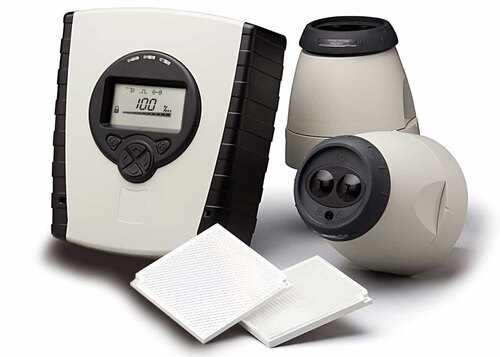Product Description
An optical beam detector is a type of sensor or device used to detect the presence or interruption of an optical beam or light path between a transmitter and a receiver. It is commonly used in various applications for security, industrial automation, and even in everyday devices like automatic doors and elevators. The basic principle behind an optical beam detector is to send a light beam from a transmitter to a receiver, and when an object obstructs the beam, the receiver detects a change in the light intensity, triggering a response or alarm.
Here are some key points about optical beam detectors:
1. Components:
a. Transmitter: Emits a focused or collimated beam of light, typically using a laser diode or LED.
b. Receiver: Detects the light beam and measures its intensity.
c. Optical path: The space through which the light beam travels.
2. Types:
a. Active: In an active optical beam detector, both the transmitter and receiver are separate components. The receiver continuously monitors the light beam, and if the beam is interrupted by an object, an alarm or signal is activated.
b. Passive: Passive beam detectors are typically used for perimeter protection. They rely on external light sources (e.g., sunlight or ambient lighting) and use retro-reflective or reflective technology to detect interruptions in the reflected light.
3. Applications:
a. Security: Optical beam detectors are used in security systems to create a perimeter around a property. When the beam is broken, it can trigger alarms or activate surveillance cameras.
b. Industrial Automation: They are used in manufacturing and conveyor systems to detect the presence of objects or for positioning applications.
c. Elevators and Automatic Doors: Optical beam detectors are often used in elevators and automatic doors to ensure safe operation by detecting obstructions.
d. Parking Lot Management: They can be used in parking lots to monitor the entry and exit of vehicles.
4. Range and Sensitivity:
Optical beam detectors come in various models with different detection ranges and sensitivity levels. Some can cover short distances, while others are designed for longer-range applications.
5. Weather and Environmental Considerations:
Outdoor optical beam detectors must be designed to withstand various weather conditions and environmental factors such as rain, snow, dust, and temperature fluctuations.
6. Alignment:
Proper alignment of the transmitter and receiver is critical for reliable operation. If the beam is misaligned, false alarms or missed detections can occur.
7. False Alarm Reduction:
Advanced optical beam detectors often incorporate technologies like multiple beam paths or digital signal processing to reduce false alarms caused by small objects, birds, or environmental factors.
FAQ:
Q. What is an optical beam detector?
Ans: An optical beam detector is a sensor device that uses a light beam to detect the presence or interruption of objects. It typically consists of a transmitter that emits a light beam and a receiver that detects changes in the intensity of that beam.
Q. How does an optical beam detector work?
Ans: The transmitter emits a light beam, which is directed toward the receiver. The receiver continuously monitors the received light intensity. When an object interrupts the light beam and reduces the received intensity, it triggers an alarm or a specific response.
Q. What are the common applications of optical beam detectors?
Ans: Optical beam detectors are used in various applications, including security systems, industrial automation, elevators, automatic doors, and parking lot management.
Q. What are the types of optical beam detectors?
Ans: There are two main types of optical beam detectors:
a. Active: These have separate transmitter and receiver units. The receiver continuously monitors the light beam emitted by the transmitter.
b. Passive: Passive beam detectors rely on external light sources and use retro-reflective or reflective technology to detect interruptions in the reflected light.
Q. What is the detection range of optical beam detectors?
Ans: The detection range varies depending on the specific model and application. Some optical beam detectors are designed for short distances, while others can cover longer ranges, ranging from a few meters to hundreds of meters.
Q. How do you align an optical beam detector?
Ans: Proper alignment of the transmitter and receiver is essential for reliable operation. This alignment ensures that the light beam passes directly from the transmitter to the receiver. Special alignment tools or procedures are often provided by the manufacturer to assist in this process.
Q. What factors can cause false alarms in optical beam detectors?
Ans: False alarms can be caused by factors such as misalignment, dirt or debris on the optics, interference from other light sources, and environmental conditions like rain or snow. Advanced detectors use technologies to minimize false alarms.
Q. Can optical beam detectors work in outdoor environments?
Ans: Yes, optical beam detectors can work outdoors, but they need to be designed to withstand various weather conditions and environmental factors, including rain, snow, dust, and temperature fluctuations.
Q. Are optical beam detectors used in conjunction with other security systems?
Ans: Yes, optical beam detectors are often integrated into larger security systems. They can trigger alarms, activate surveillance cameras, or initiate other security measures when an intrusion is detected.
Q. What are the advantages of using optical beam detectors?
Ans: Advantages of optical beam detectors include their ability to cover long distances, immunity to electromagnetic interference, and suitability for applications where physical barriers or other sensors may not be practical.
Q. Are there any limitations to optical beam detectors?
Ans: Optical beam detectors may have limitations in adverse weather conditions, and they require proper alignment for reliable operation. Additionally, they may not work well in very dusty or foggy environments.
Q. Do optical beam detectors require regular maintenance?
Ans: Yes, optical beam detectors should undergo regular maintenance to ensure they remain clean, aligned, and free from obstructions that could lead to false alarms or reduced performance.
